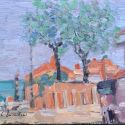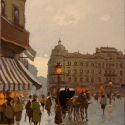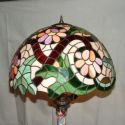
One of the most popular painters of late 19th century France, Toulouse-Lautrec was last the focus of a retrospective in 1991, when a major exhibit of his work was displayed in London and Paris. Now, The Art Institute of Chicago, in collaboration with the National Gallery of Art in Washington, D.C., is doing a more selective presentation. The exhibition, "Toulouse-Lautrec and Montmartre," showcases paintings, drawings, posters, prints and sculptures the artist did from 1888 to 1896. It's the decade of Toulouse-Lautrec's work that art historians consider to be the high point of his career. The purpose of the exhibit, which opens on July 16 and runs through October 10, is to place Toulouse-Lautrec in his artistic element. With that in mind, it includes not only selections of Toulouse-Lautrec's works but those of his contemporaries. Toulouse-Lautrec is intricately connected with Montmartre. He was so successful with his portraits of celebrities, Groom said, that he became one of the main attractions of the Moulin Rouge, a music hall in Montmartre that has been the subject of many books and movies, including John Huston's 1953 film, "Moulin Rouge," and the 2002 movie of the same title starring Nicole Kidman. The exhibit showcases the period of Toulouse-Lautrec's life in which he painted some of his best-known works. Included are more than 150 of the artist's paintings and drawings of Montmartre, which have been brought together from public and private collections from the Art Institute and from around the world. Also on display are another 100 works by other artists who were part of the artistic scene in Montmartre, such as Edgar Degas, Vincent van Gogh and Edouard Manet. Seeing Toulouse-Lautrec in this wider context of the artistic landscape of the period will allow viewers to experience a magnificent selection of his works, as well as an appreciation for the artistic climate of the latter part of the 19th century, which was so different from that of the earlier Impressionist generation. Montmartre had a mind-set that crossed the boundaries of France's morals and went beyond the standards of decency of the time. And it provided a world in which Toulouse-Lautrec's art flourished. Though he came from a wealthy background (his father was a count), Toulouse-Lautrec was more comfortable with the performers and prostitutes of Montmartre than his own privileged society. He was an insider of Montmartre. He lived there and knew the people of the town; they were friends of his. He loved Montmartre's seductive culture that he referred to as 'outside the law.' Though the area resembled a small village on a hill overlooking Paris, Montmartre was the city's center of avant-garde, underground culture that condoned prostitution, crime and an anti-social attitude. It offered a decadent, anything-goes culture that was a draw for wealthy Parisians looking for forbidden excitement, visitors seeking risqu glamour, and anti-establishment rebels and artists such as Henri de Toulouse-Lautrec (1864-1901). The performers Toulouse-Lautrec met in Montmartre's dance halls, bars, cabarets, cafes and brothels became immortalized in his art. He captured the notorious stars of the period in his colorful caricatures and unique posters. One of Toulouse-Lautrec's best-known works is the "Moulin Rouge: La Goulue" (the stage name of Louise Weber), in which La Goulue is depicted in the midst of a shocking can-can. The poster was a bold stroke of artistic daring that stunned the high-minded world of the Paris elite and launched his artistic career in 1891. He followed that with other famous posters of cabaret performers such as Aristide Bruant, Jane Avril and May Milton. The nightclubs in which these personalities appeared the Moulin Rouge, the Moulin de la Galette, the Chat Noir are also featured in Toulouse-Lautrec paintings, making them as famous as its performers. It was also his graphic technique, which made a strong impact on people's ideas about art, his powerful use of color and his distinctive images. He was also the first artist to use silhouettes and bold designs in posters of which the focus was on particular personalities known to the public. The exhibit also features letters, songs sheets, advertisements, tickets, illustrated invitations and other printed materials. That memorabilia tells us a lot about Toulouse-Lautrec, not only as an artist but as a person. He was a sickly child whose weak bones led to leg fractures that didn't heal properly and resulted in stunted growth. He was less than 5 feet tall and had difficulty walking throughout his life. Many of his biographers have suggested Toulouse-Lautrec's medical hardships were the result of the intermarriage of his parents, who were first cousins. Toulouse-Lautrec became an alcoholic, and died in 1901 at the age of 36. July 2005 Image - "Quadrille, Toulouse-Lautrec
 One of the most popular painters of late 19th century France, Toulouse-Lautrec was last the focus of a retrospective in 1991, when a major exhibit of his work was displayed in London and Paris. Now, The Art Institute of Chicago, in collaboration with the National Gallery of Art in Washington, D.C., is doing a more selective presentation. The exhibition, "Toulouse-Lautrec and Montmartre," showcases paintings, drawings, posters, prints and sculptures the artist did from 1888 to 1896. It's the decade of Toulouse-Lautrec's work that art historians consider to be the high point of his career. The purpose of the exhibit, which opens on July 16 and runs through October 10, is to place Toulouse-Lautrec in his artistic element. With that in mind, it includes not only selections of Toulouse-Lautrec's works but those of his contemporaries. Toulouse-Lautrec is intricately connected with Montmartre. He was so successful with his portraits of celebrities, Groom said, that he became one of the main attractions of the Moulin Rouge, a music hall in Montmartre that has been the subject of many books and movies, including John Huston's 1953 film, "Moulin Rouge," and the 2002 movie of the same title starring Nicole Kidman. The exhibit showcases the period of Toulouse-Lautrec's life in which he painted some of his best-known works. Included are more than 150 of the artist's paintings and drawings of Montmartre, which have been brought together from public and private collections from the Art Institute and from around the world. Also on display are another 100 works by other artists who were part of the artistic scene in Montmartre, such as Edgar Degas, Vincent van Gogh and Edouard Manet. Seeing Toulouse-Lautrec in this wider context of the artistic landscape of the period will allow viewers to experience a magnificent selection of his works, as well as an appreciation for the artistic climate of the latter part of the 19th century, which was so different from that of the earlier Impressionist generation. Montmartre had a mind-set that crossed the boundaries of France's morals and went beyond the standards of decency of the time. And it provided a world in which Toulouse-Lautrec's art flourished. Though he came from a wealthy background (his father was a count), Toulouse-Lautrec was more comfortable with the performers and prostitutes of Montmartre than his own privileged society. He was an insider of Montmartre. He lived there and knew the people of the town; they were friends of his. He loved Montmartre's seductive culture that he referred to as 'outside the law.' Though the area resembled a small village on a hill overlooking Paris, Montmartre was the city's center of avant-garde, underground culture that condoned prostitution, crime and an anti-social attitude. It offered a decadent, anything-goes culture that was a draw for wealthy Parisians looking for forbidden excitement, visitors seeking risqu glamour, and anti-establishment rebels and artists such as Henri de Toulouse-Lautrec (1864-1901). The performers Toulouse-Lautrec met in Montmartre's dance halls, bars, cabarets, cafes and brothels became immortalized in his art. He captured the notorious stars of the period in his colorful caricatures and unique posters. One of Toulouse-Lautrec's best-known works is the "Moulin Rouge: La Goulue" (the stage name of Louise Weber), in which La Goulue is depicted in the midst of a shocking can-can. The poster was a bold stroke of artistic daring that stunned the high-minded world of the Paris elite and launched his artistic career in 1891. He followed that with other famous posters of cabaret performers such as Aristide Bruant, Jane Avril and May Milton. The nightclubs in which these personalities appeared the Moulin Rouge, the Moulin de la Galette, the Chat Noir are also featured in Toulouse-Lautrec paintings, making them as famous as its performers. It was also his graphic technique, which made a strong impact on people's ideas about art, his powerful use of color and his distinctive images. He was also the first artist to use silhouettes and bold designs in posters of which the focus was on particular personalities known to the public. The exhibit also features letters, songs sheets, advertisements, tickets, illustrated invitations and other printed materials. That memorabilia tells us a lot about Toulouse-Lautrec, not only as an artist but as a person. He was a sickly child whose weak bones led to leg fractures that didn't heal properly and resulted in stunted growth. He was less than 5 feet tall and had difficulty walking throughout his life. Many of his biographers have suggested Toulouse-Lautrec's medical hardships were the result of the intermarriage of his parents, who were first cousins. Toulouse-Lautrec became an alcoholic, and died in 1901 at the age of 36. July 2005 Image - "Quadrille, Toulouse-Lautrec
One of the most popular painters of late 19th century France, Toulouse-Lautrec was last the focus of a retrospective in 1991, when a major exhibit of his work was displayed in London and Paris. Now, The Art Institute of Chicago, in collaboration with the National Gallery of Art in Washington, D.C., is doing a more selective presentation. The exhibition, "Toulouse-Lautrec and Montmartre," showcases paintings, drawings, posters, prints and sculptures the artist did from 1888 to 1896. It's the decade of Toulouse-Lautrec's work that art historians consider to be the high point of his career. The purpose of the exhibit, which opens on July 16 and runs through October 10, is to place Toulouse-Lautrec in his artistic element. With that in mind, it includes not only selections of Toulouse-Lautrec's works but those of his contemporaries. Toulouse-Lautrec is intricately connected with Montmartre. He was so successful with his portraits of celebrities, Groom said, that he became one of the main attractions of the Moulin Rouge, a music hall in Montmartre that has been the subject of many books and movies, including John Huston's 1953 film, "Moulin Rouge," and the 2002 movie of the same title starring Nicole Kidman. The exhibit showcases the period of Toulouse-Lautrec's life in which he painted some of his best-known works. Included are more than 150 of the artist's paintings and drawings of Montmartre, which have been brought together from public and private collections from the Art Institute and from around the world. Also on display are another 100 works by other artists who were part of the artistic scene in Montmartre, such as Edgar Degas, Vincent van Gogh and Edouard Manet. Seeing Toulouse-Lautrec in this wider context of the artistic landscape of the period will allow viewers to experience a magnificent selection of his works, as well as an appreciation for the artistic climate of the latter part of the 19th century, which was so different from that of the earlier Impressionist generation. Montmartre had a mind-set that crossed the boundaries of France's morals and went beyond the standards of decency of the time. And it provided a world in which Toulouse-Lautrec's art flourished. Though he came from a wealthy background (his father was a count), Toulouse-Lautrec was more comfortable with the performers and prostitutes of Montmartre than his own privileged society. He was an insider of Montmartre. He lived there and knew the people of the town; they were friends of his. He loved Montmartre's seductive culture that he referred to as 'outside the law.' Though the area resembled a small village on a hill overlooking Paris, Montmartre was the city's center of avant-garde, underground culture that condoned prostitution, crime and an anti-social attitude. It offered a decadent, anything-goes culture that was a draw for wealthy Parisians looking for forbidden excitement, visitors seeking risqu glamour, and anti-establishment rebels and artists such as Henri de Toulouse-Lautrec (1864-1901). The performers Toulouse-Lautrec met in Montmartre's dance halls, bars, cabarets, cafes and brothels became immortalized in his art. He captured the notorious stars of the period in his colorful caricatures and unique posters. One of Toulouse-Lautrec's best-known works is the "Moulin Rouge: La Goulue" (the stage name of Louise Weber), in which La Goulue is depicted in the midst of a shocking can-can. The poster was a bold stroke of artistic daring that stunned the high-minded world of the Paris elite and launched his artistic career in 1891. He followed that with other famous posters of cabaret performers such as Aristide Bruant, Jane Avril and May Milton. The nightclubs in which these personalities appeared the Moulin Rouge, the Moulin de la Galette, the Chat Noir are also featured in Toulouse-Lautrec paintings, making them as famous as its performers. It was also his graphic technique, which made a strong impact on people's ideas about art, his powerful use of color and his distinctive images. He was also the first artist to use silhouettes and bold designs in posters of which the focus was on particular personalities known to the public. The exhibit also features letters, songs sheets, advertisements, tickets, illustrated invitations and other printed materials. That memorabilia tells us a lot about Toulouse-Lautrec, not only as an artist but as a person. He was a sickly child whose weak bones led to leg fractures that didn't heal properly and resulted in stunted growth. He was less than 5 feet tall and had difficulty walking throughout his life. Many of his biographers have suggested Toulouse-Lautrec's medical hardships were the result of the intermarriage of his parents, who were first cousins. Toulouse-Lautrec became an alcoholic, and died in 1901 at the age of 36. July 2005 Image - "Quadrille, Toulouse-Lautrec

































